Web-Based System for the Remote Monitoring and Management of Precision Irrigation: A Case Study in an Arid Region of Argentina
Abstract
1. Introduction
1.1. Precision Agriculture in Argentina
1.2. Traditional Irrigation and Precision Irrigation
1.3. Local Situation and Objectives
2. Materials and Methods
2.1. Description of the Developed Precision Irrigation System (PISys)
2.1.1. In-Field Devices
- An Internet connection makes it possible to transmit data to a Web Server. This connection is also used to access the system remotely.
- A Wi-Fi network (Ubiquity Nanostation M2 2.4 GHz) links a Programmable Logic Controller (PLC), installed at the irrigation system, with the server PC and allows for the use of mobile devices, such as tablets or smartphones, to locally connect to the server.
- A Radio Modem device, at 470 MHz, is used to communicate with the measurement stations and the weather stations.
- A mobile phone connection (GPRS-GSM modem, G24 Motorola) allows the system to send text messages with alarms or other information related to the system functioning. In the event of a failure in the internet connection, this system act as an auxiliary link to access the information on the server PC.
2.1.2. Web Service
2.1.3. Clients and Remote Users
2.1.4. External Supervisor
2.2. Web-Based Software
3. Field Implementation
3.1. Description of the Orchard
3.2. Irrigation Equipment
3.3. In-Field Measurement Stations
3.4. Irrigation Strategies
3.5. Irrigation Treatments
3.6. Irrigation Programming Set
4. Results and Discussion
4.1. Watering Monitoring
4.2. Pilot Experiences Results
5. Conclusions
Author Contributions
Funding
Acknowledgments
Conflicts of Interest
References
- King, A. Techonolgy: The future of agriculture. Nature 2017, 44, 21–23. [Google Scholar] [CrossRef] [PubMed]
- Zhang, N.; Wang, M.; Wang, N. Precision agriculture—A worldwide overview. Comput. Electron. Agric. 2002, 36, 113–132. [Google Scholar] [CrossRef]
- Suprem, A.; Mahalik, N.; Kim, K. A review on application of technology systems, standards and interfaces for agriculture and food sector. Comput. Stand. Interfaces 2013, 35, 355–364. [Google Scholar] [CrossRef]
- Doerge, T.A. Defining management zones for precision agriculture. Crop Insights 1998, 8, 1–5. [Google Scholar]
- Johnson, C.K.; Mortensen, D.A.; Wienhold, B.J.; Shanhan, J.F.; Doran, J.W. Site-specific management zones based on soil electrical conductivity in a semiarid cropping system. Agron. J. 2003, 95, 303–315. [Google Scholar] [CrossRef]
- Schepers, A.R.; Shanahan, J.F.; Liebig, M.A.; Schepers, J.S.; Johnson, S.H.; Luchiari, A., Jr. Appropriateness of management zones for characterizing spatial variability of soil properties and irrigated corn yields across years. Agron. J. 2004, 96, 195–203. [Google Scholar] [CrossRef]
- Stafford, J.V. Implementing precision agriculture in the 21st century. J. Agric. Eng. Res. 2000, 76, 267–275. [Google Scholar] [CrossRef]
- Méndez, A.; Vélez, J.; Villarroel, D.; Scaramuzza, F. Evolución de la Agricultura de Precisión en Argentina en los últimos 15 años. Red Agric. Precis. 2014, 13, 09. [Google Scholar]
- Schugurensky, C.; Capraro, F. Control automático de riego agrícola con sensores capacitivos de humedad de suelo. Aplicaciones en vid y olivo. In Proceedings of the XVIII Congreso de la Asociación Chilena de Control Automático (ACCA), Santiago, Chile, 10–12 December 2008. [Google Scholar]
- Gómez del Campo, M.; Morales Sillero, A.; Vita Serman, F.; Rousseaux, M.C.; Searles, P.S. El olivar en los valles cálidos del Noroeste de Argentina. Olivae 2010, 114, 23–45. [Google Scholar]
- Vita Serman, F.; Matías, A. Zonas Olivícolas de Argentina, Contexto y Prospectiva de la Cadena de Olivo. Instituto Nacional de Tecnología Agropecuaria (INTA). 2013. Electronic Version. Available online: https://inta.gob.ar/sites/default/files/script-tmp-inta_programa-nacional-frutales-cadena-olivo.pdf (accessed on 31 October 2018).
- Capraro, F.; Tosetti, S.; Vita Serman, F. Supervisory control and data acquisition software for drip irrigation control in olive groves. An experience in an arid region of Argentina. Acta Hortic. 2014, 1057, 423–429. [Google Scholar] [CrossRef]
- Israelsen, O.W.; Hansen, V.E. Irrigation Principles and Practices; John Wiley and Sons Inc.: New York, NY, USA, 1962; Chapter 1. [Google Scholar]
- Nugteren, J. Introduction to Irrigation; Civil and Irrigation Engineering Department, Agricultural University: Wageningen, The Netherlands, 1970; Chapter 1. [Google Scholar]
- Allen, R.G.; Pereira, L.; Raes, D.; Smith, M. Crop Evapotranspiration. Guidelines for Computing Crop Water Requirements. FAO Irrigation and Drainage Nº56, 1998. Italy. Available online: http://www.fao.org/docrep/x0490e/x0490e00.htm (accessed on 31 October 2018).
- Cardenas Lailhacar, B.; Dukes, M.D. Precision of soil moisture sensor irrigation controllers under field conditions. Agric. Water Manag. 2010, 97, 666–672. [Google Scholar] [CrossRef]
- Brinkhoff, J.; Hornbuckle, J.; Dowling, T. Multisensor Capacitance Probes for Simultaneously Monitoring Rice Field Soil-Water-Crop-Ambient Conditions. Sensors 2018, 18, 53. [Google Scholar] [CrossRef] [PubMed]
- Turner, N.C. Measurement of plant water status by the pressure chamber technique. J. Irrig. Sci. 1998, 9, 289–308. [Google Scholar] [CrossRef]
- Goldhamer, D.A.; Fereres, E.; Mats, M.; Girona, J.; Cohen, M. Sensitivity of continuous and discrete plant and soil water status monitoring in peach trees subjected to deficit irrigation. J. Am. Soc. Hort. Sci. 1999, 1244, 437–444. [Google Scholar]
- Moriana, A.; Fereres, E. Establishing reference values of trunk diameter fluctuations and stem water potential for irrigation scheduling of olive trees. Acta Hortic. 2004, 664, 407–412. [Google Scholar] [CrossRef]
- Ortuño, M.F.; Conejero, W.; Moreno, F.; Moriana, A.; Intrigliolo, D.S.; Biel, C.; Mellisho, C.D.; Pérez-Pastor, A.; Domingo, R.; Ruiz-Sánchez, M.C.; et al. Could trunk diameter sensors be used in woody crops for irrigation scheduling? A review of current knowledge and future perspectives. Agric. Water Manag. 2010, 97, 1–11. [Google Scholar] [CrossRef]
- Daccache, A.; Knox, J.W.; Weatherhead, E.K.; Daneshkhah, A.; Hess, T.M. Implementing precision irrigation in a humid climate—Recent experiences and on-going challenges. Agric. Water Manag. 2014, 147, 135–143. [Google Scholar] [CrossRef]
- Smith, R.J.; Baillie, J.N.; Mc Carthy, A.C.; Raine, S.R.; Baillie, C.P. Review of Precision Irrigation Technologies and Their Application; National Centre for Engineering in Agriculture, University of Southern Queensland: Toowoomba, Australia, 2010. [Google Scholar]
- Misra, R.; Raine, S.R.; Pezzaniti, D.; Charlesworth, P.; Hancock, N.H. A Scoping Study on Measuring and Monitoring Tools and Technology for Precision Irrigation; Irrigation Matter Series; CRC for Irrigation Futures: Toowoomba, Australia, 2005. [Google Scholar]
- Raine, S.R.; Meyer, W.S.; Rassam, D.W.; Hutson, J.L.; Cook, F.J. Soil-water and solute movement under precision irrigation: Knowledge gaps for managing sustainable root zones. Irrig. Sci. 2007, 26, 91–100. [Google Scholar] [CrossRef]
- Adeyemi, O.; Grove, I.; Peets, S.; Norton, T. Advanced Monitoring and Management Systems for Improving Sustainability in Precision Irrigation. Sustainability 2017, 9, 353. [Google Scholar] [CrossRef]
- Bogena, H.R.; Huisman, J.A.; Oberdorster, C.; Vereecken, H. Evaluation of a low-cost soil water content sensor for wireless network applications. J. Hydrol. 2007, 344, 32–42. [Google Scholar] [CrossRef]
- López Riquelme, J.A.; Soto, F.; Suardíaz, J.; Sánchez, P.; Iborra, A.; Vera, J.A. Wireless Sensor Networks for precision horticulture in Southern Spain. Comput. Electron. Agric. 2009, 68, 25–35. [Google Scholar] [CrossRef]
- Escolar Díaz, S.; Carretero Pérez, J.; Calderón Mateos, A.; Marinescu, M.C.; Bergua Guerra, B. A novel methodology for the monitoring of the agricultural production process based on wireless sensor networks. Comput. Electron. Agric. 2011, 76, 252–265. [Google Scholar] [CrossRef]
- Pardossi, A.; Incrocci, L.; Incrocci, G.; Malorgio, F.; Battista, P.; Bacci, L.; Rapi, B.; Marzialetti, P.; Hemming, J.; Balendonck, J. Root Zone Sensors for Irrigation Management in Intensive Agriculture. Sensors 2009, 9, 2809–2835. [Google Scholar] [CrossRef] [PubMed]
- Coates, R.W.; Delwiche, M.J.; Broad, A.; Holler, M. Wireless sensor network with irrigation valve control. Comput. Electron. Agric. 2013, 96, 13–22. [Google Scholar] [CrossRef]
- Vita Serman, F.; Capraro, F.; Tosetti, S.; Cornejo, V.; Carelli, A.; Ceci, L. Intelligent irrigation control in olive groves (Oleaeuropaea L.): A novel approach for water resource optimization. Acta Hortic. 2012, 949, 343–350. [Google Scholar] [CrossRef]
- Goumopoulos, C.; O’Flynn, B.; Kameas, A. Automated zone-specific irrigation with wireless sensor/actuator network and adaptable decision support. Comput. Electron. Agric. 2014, 105, 20–33. [Google Scholar] [CrossRef]
- O’Shaughnessy, S.A.; Evett, S.R. Developing wireless sensor networks for monitoring crop canopy temperature using a moving sprinkler system as a platform. Appl. Eng. Agric. 2010, 26, 331–341. [Google Scholar] [CrossRef]
- Evans, R.G.; Iversen, W.M.; Kim, Y. Integrated decision support, sensor networks and adaptive control for wireless site-specific sprinkler irrigation. Appl. Eng. Agric. 2012, 28, 377–387. [Google Scholar] [CrossRef]
- McCarthy, A.C.; Hancock, N.H.; Raine, S.R. Advanced process control of irrigation: The current state and an analysis to aid future development. Irrig. Sci. 2013, 31, 183–192. [Google Scholar] [CrossRef]
- Evans, R.G.; LaRue, J.; Stone, K.C.; King, B.A. Adoption of site-specific variable rate sprinkler irrigation systems. Irrg. Sci. 2013, 3, 871–887. [Google Scholar] [CrossRef]
- Ndzi, D.L.; Kamarudin, L.M.; Mohammad, E.A.A.; Zakaria, A.; Ahmad, R.B.; Fareq, M.M.A.; Shaka, A.Y.M.; Jafaa, M.N. Vegetation attenuation measurements and modeling in plantations for wireless sensor network planning. Prog. Electromagn. Res. 2012, 36, 283–301. [Google Scholar] [CrossRef]
- Savage, N.; Ndzi, D.L.; Seville, A.; Vilar, E.; Austin, J. Radio wave propagation through vegetation: Factors influencing signal attenuation. Radio Sci. 2003, 38. [Google Scholar] [CrossRef]
- Jawad, H.M.; Nordin, R.; Gharghan, S.K.; Jawad, A.M.; Ismail, M. Energy-Efficient Wireless Sensor Networks for Precision Agriculture: A Review. Sensors 2017, 17, 1781. [Google Scholar] [CrossRef] [PubMed]
- Doorenbos, J.; Pruitt, W.O. Guidelines for Predicting Crop Water Requirements, 2nd ed.; FAO Irrigation and Drainage Paper 24; Food and Agriculture Organization: Rome, Italy, 1976. [Google Scholar]
- Hypertext Pre-Processor. Available online: www.php.net (accessed on 31 October 2018).
- Object-Oriented Computer Programming Language. Available online: www.javascript.com/ (accessed on 31 October 2018).
- MySQL Open Source Database. Available online: www.mysql.com (accessed on 31 October 2018).
- Python Software Foundation, Web Services. Available online: https://wiki.python.org/moin/WebServices (accessed on 31 October 2018).
- Cobos, D.; Chambers, C. Calibrating ECH2O Soil Moisture Sensors. Application Note. Decagon Devices. 2010. Available online: www.decagon.com (accessed on 31 October 2018).
- Orgaz, F.; Testi, L.; Villalobos, F.; Fereres, E. Water requirements of olive orchards–II: Determination of crop coefficients for irrigation scheduling. Irrig Sci. 2006, 24, 77. [Google Scholar] [CrossRef]
- Correa-Tedesco, G.; Rousseaux, M.C.; Searles, P.S. Plant growth and yield responses in olive (Olea europaea) to different irrigation levels in an arid region of Argentina. Agric. Water Manag. 2010, 97, 1829–1837. [Google Scholar] [CrossRef]
- Fereres, E.; Soriano, M.A. Deficit irrigation for reducing agricultural water use. J. Exp. Bot. 2007, 58, 147–159. [Google Scholar] [CrossRef] [PubMed]
- Behboudian, M.H. Deficit irrigation in decidious orchards. Hort. Rev. 1997, 21, 105–131. [Google Scholar]
- Goldhamer, D.; Dunai, J.; Ferguson, L.; Lavee, S.; Klein, I. Irrigation requirements of olive trees and responses to sustained deficit irrigation. Acta Hortic. 1994, 356, 172–175. [Google Scholar] [CrossRef]
- Moriana, A.; Pérez-López, D.; Gómez Rico, A.; Salvador, M.; Olmedilla, N.; Ribas, F.; Fregapane, G. Irrigation scheduling for tradicional, low-density olive orchads: Water relations and influence on oil characteristics. Agric. Water Manag. 2007, 87, 171–179. [Google Scholar] [CrossRef]
- McCutchan, H.; Shackel, K.A. Stem Water Potential as a Sensitive Indicator of Water Stress in Prune Trees (Prunus domestica L. Cv. French.). J. Am. Soc. Hortic. Sci. 1992, 117, 607–611. [Google Scholar]
- Rousseaux, M.C.; Figuerola, P.I.; Correa-Tedesco, G.; Searles, P.S. Seasonal variations in sap flow and soil evaporation in an olive (Olea europaea L.) grove under two irrigation regimes in an arid region of Argentina. Agric. Water Manag. 2009, 96, 1037–1044. [Google Scholar] [CrossRef]
- Vita Serman, F.; Pacheco, D.; Olguín, A.; Bueno, L.; Carelli, A.; Capraro, F. Effect of regulated deficit irrigation strategies on productivity, quality and water use efficiency in a high-density ‘Arbequina’ olive orchard located in an arid region of Argentina. Acta Hortic. 2011, 888, 81–88. [Google Scholar] [CrossRef]
- Fernández, J.E.; Perez-Martin, A.; Torres-Ruiz, J.M.; Cuevas, M.V.; Rodriguez-Dominguez, C.M.; Elsayed-Farag, S.; Morales-Sillero, A.; García, J.M.; Hernandez-Santana, V.; Diaz-Espejo, A. A regulated deficit irrigation strategy for hedgerow olive orchards with high plant density. Plant Soil 2013, 372, 279–295. [Google Scholar] [CrossRef]
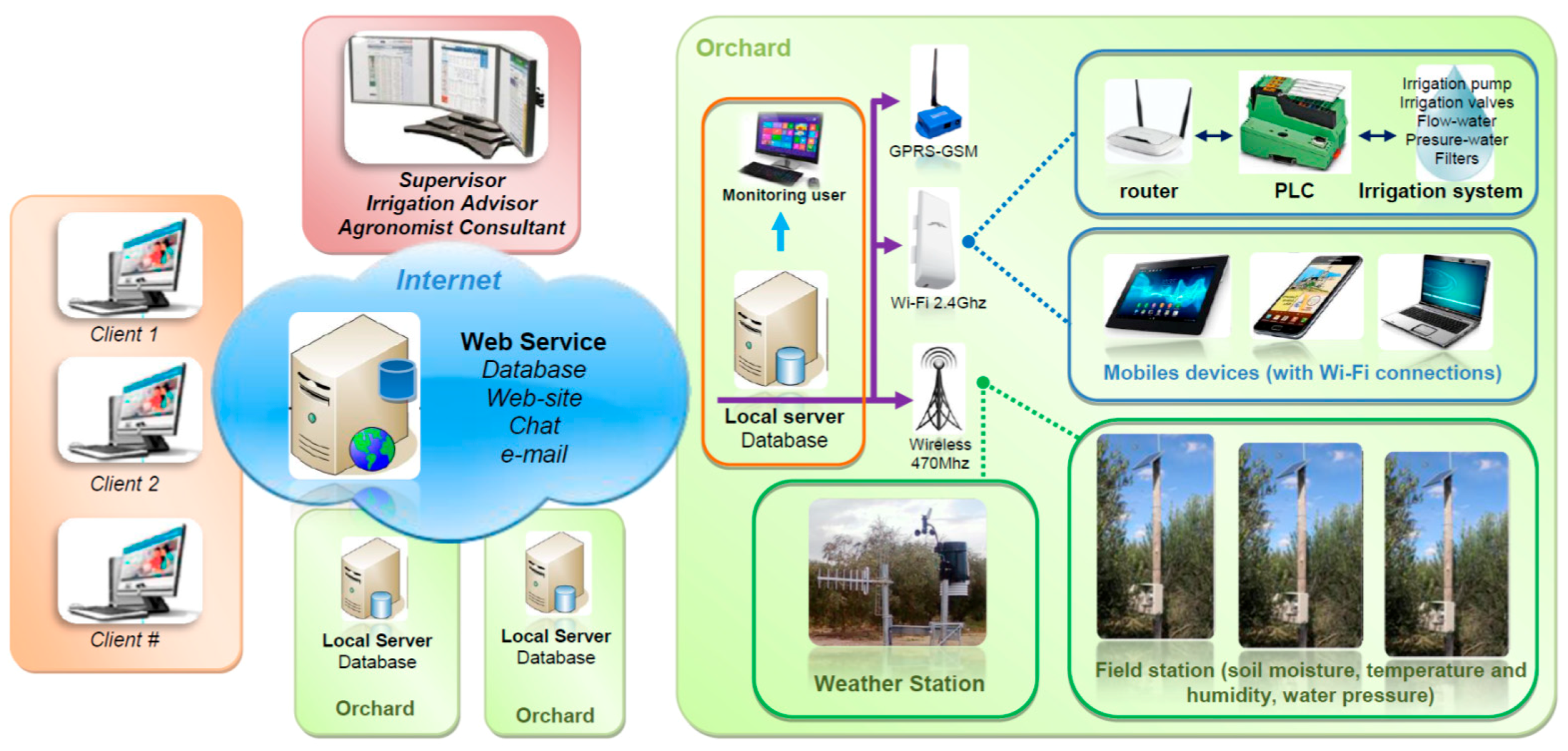

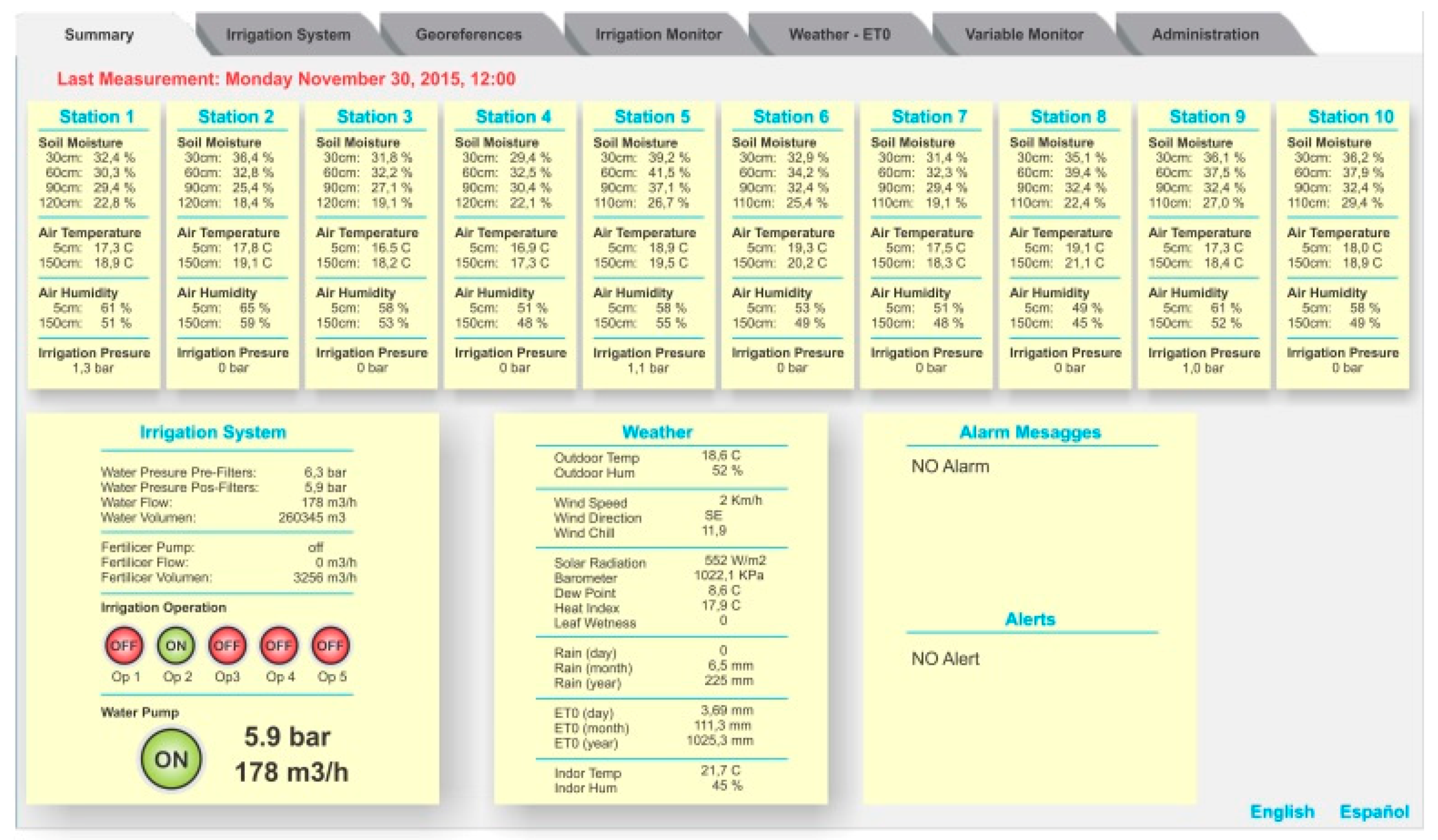
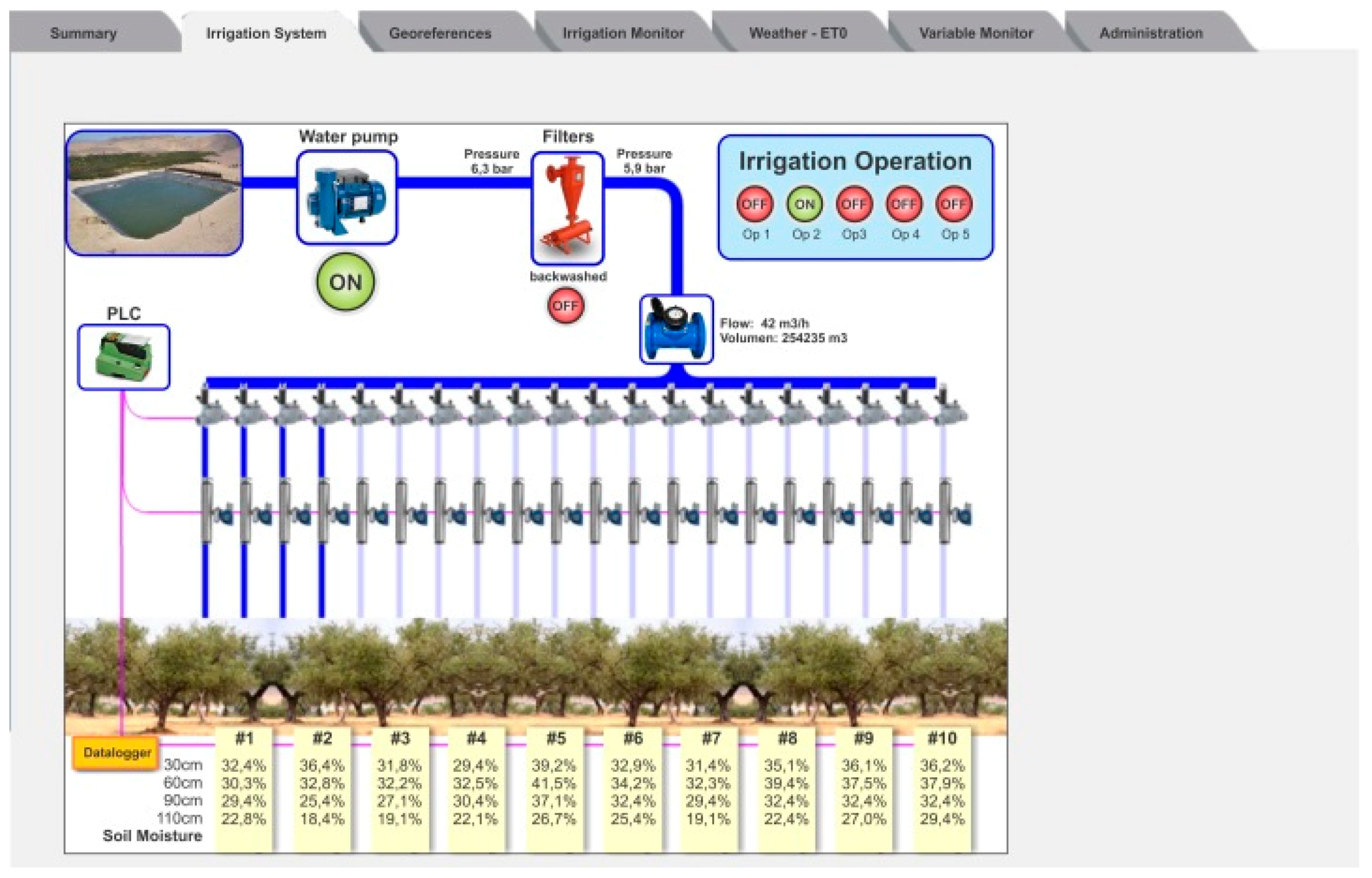
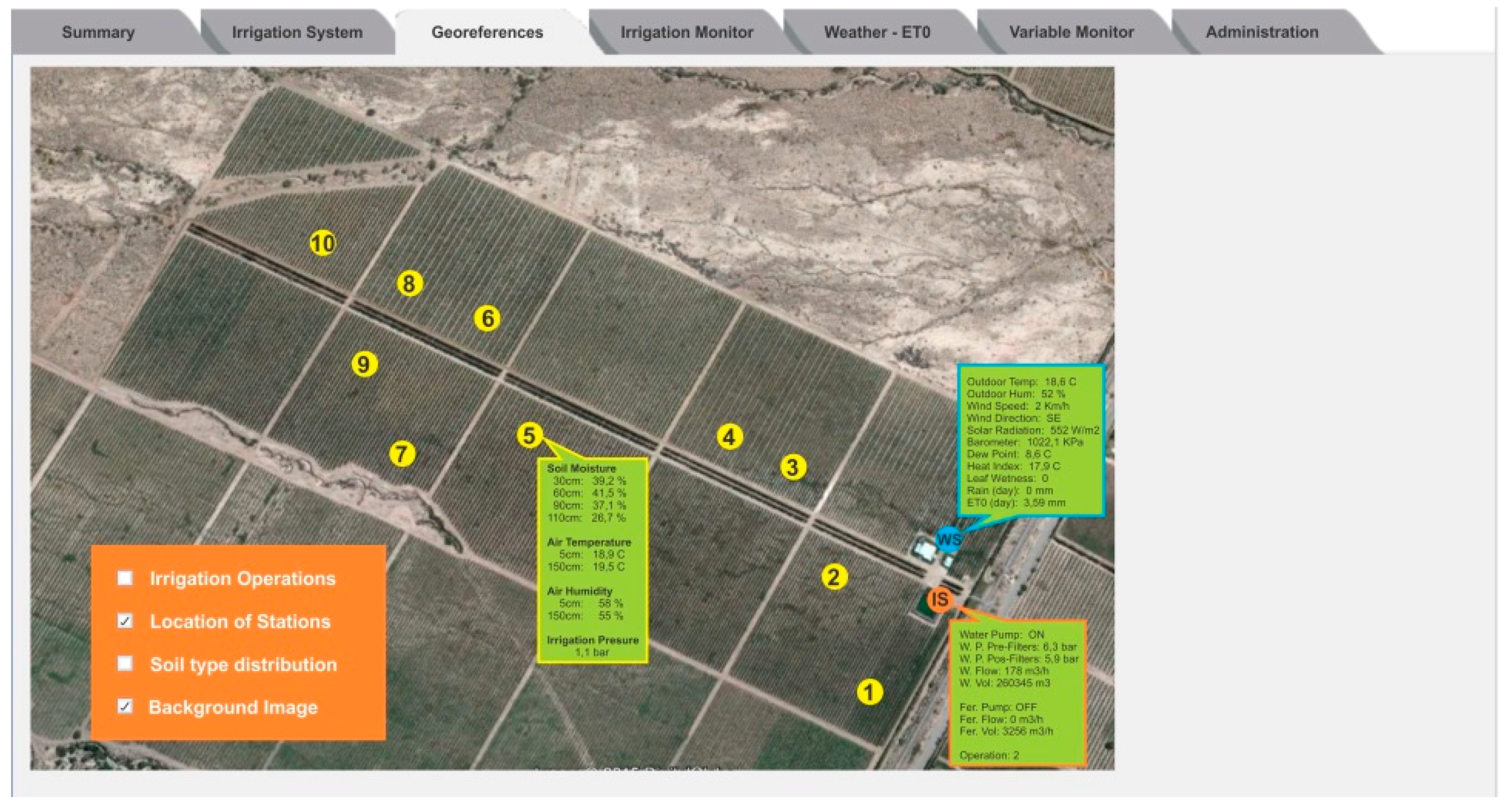

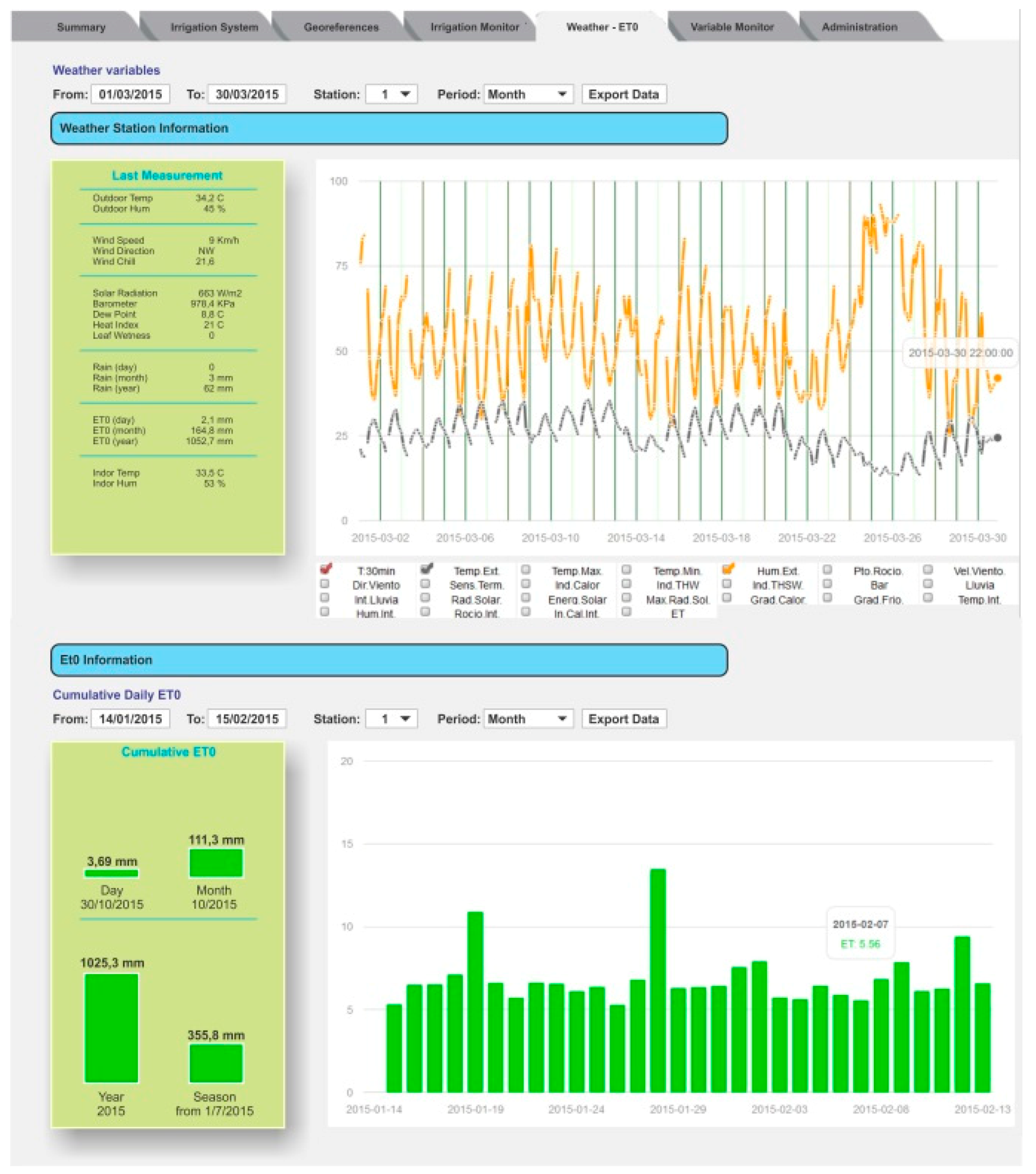
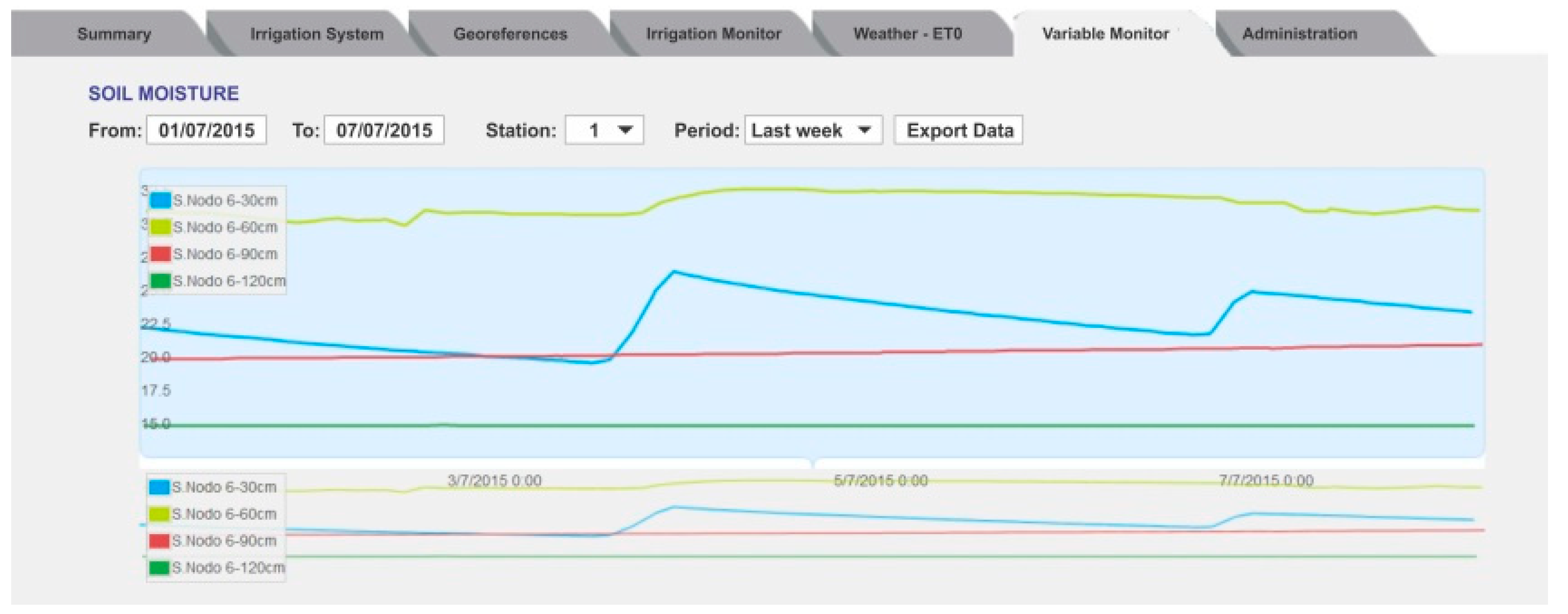
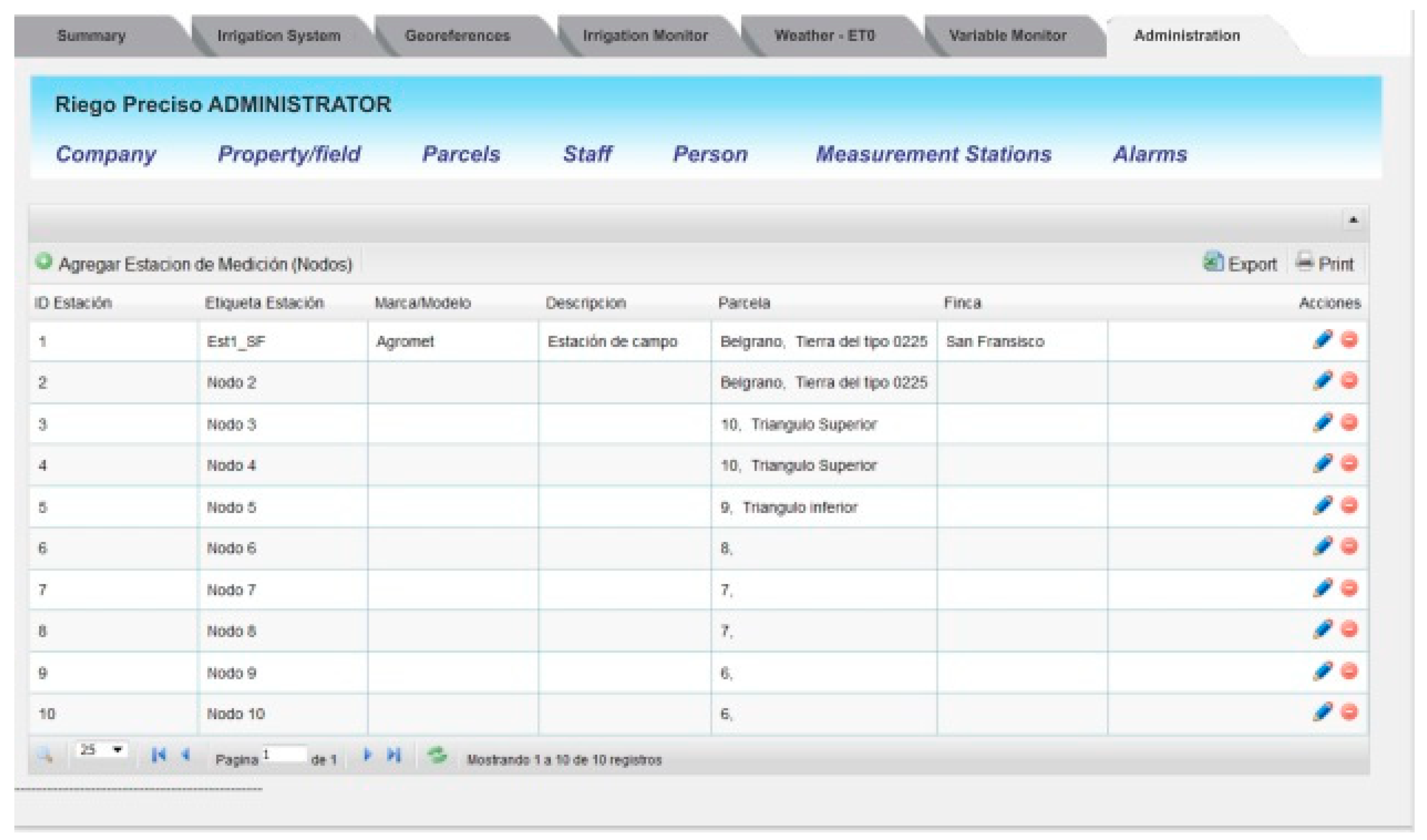
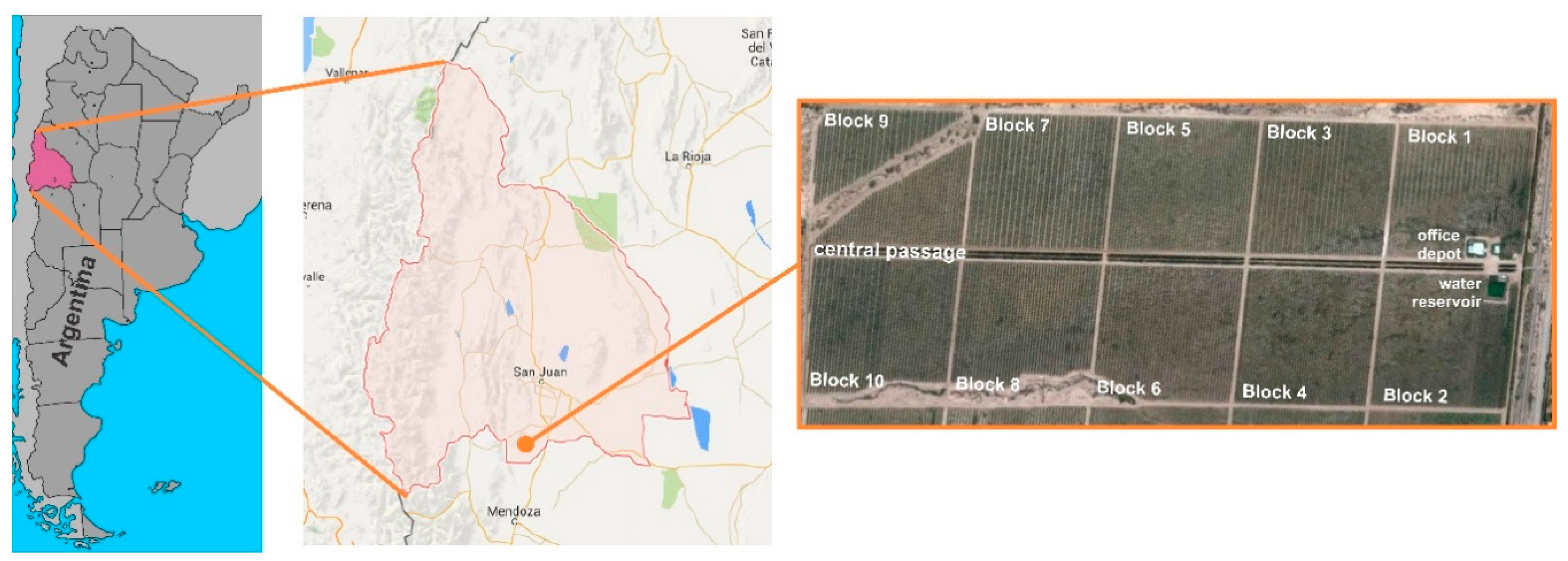
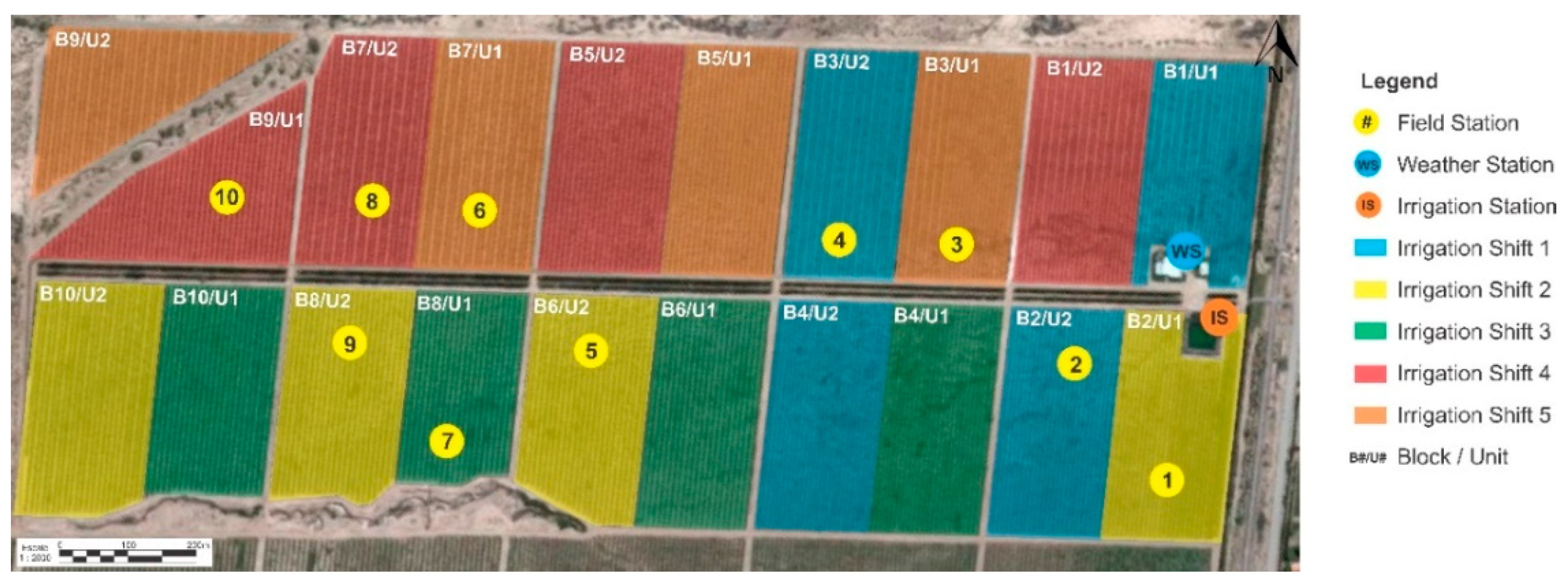


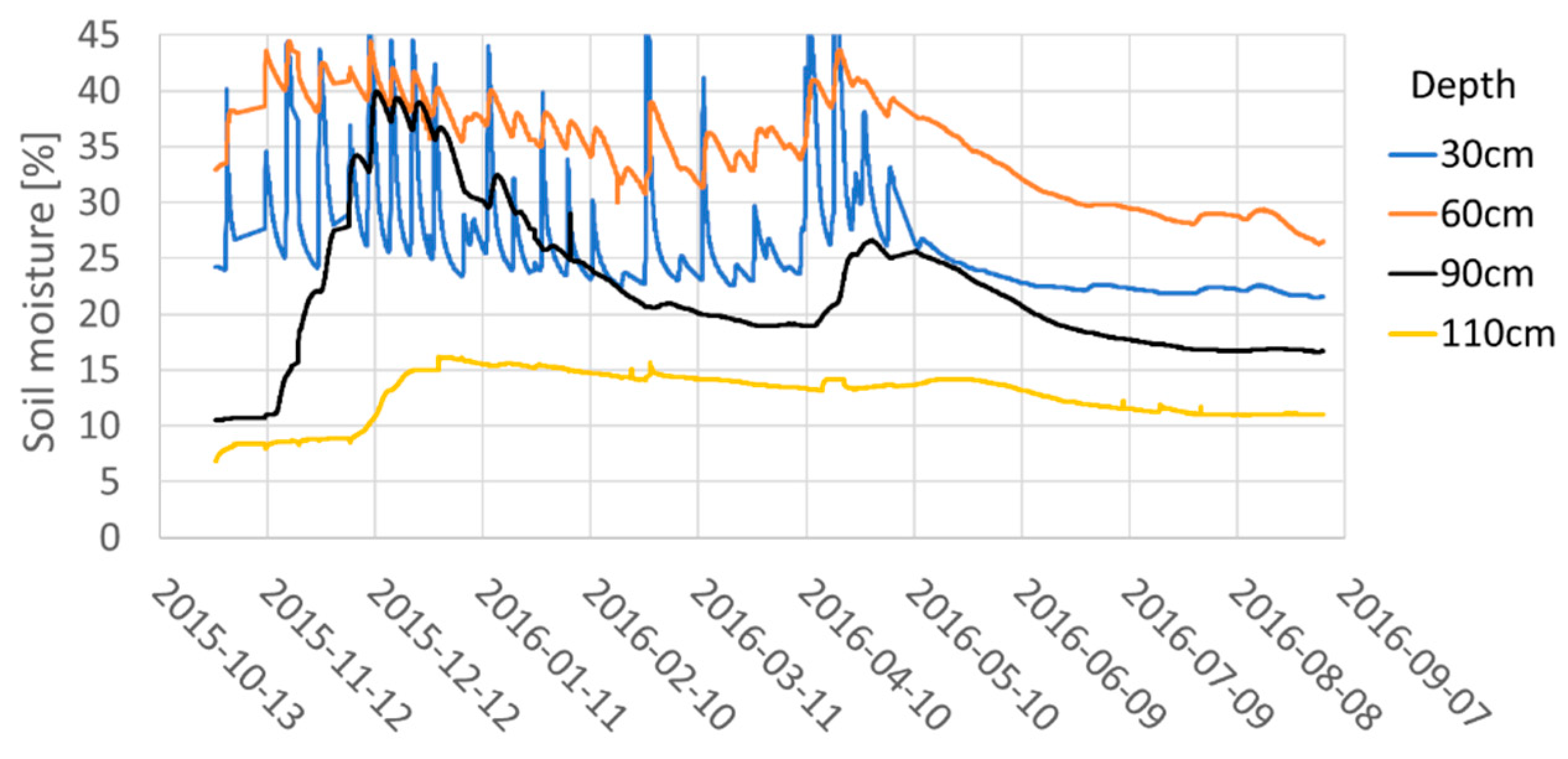

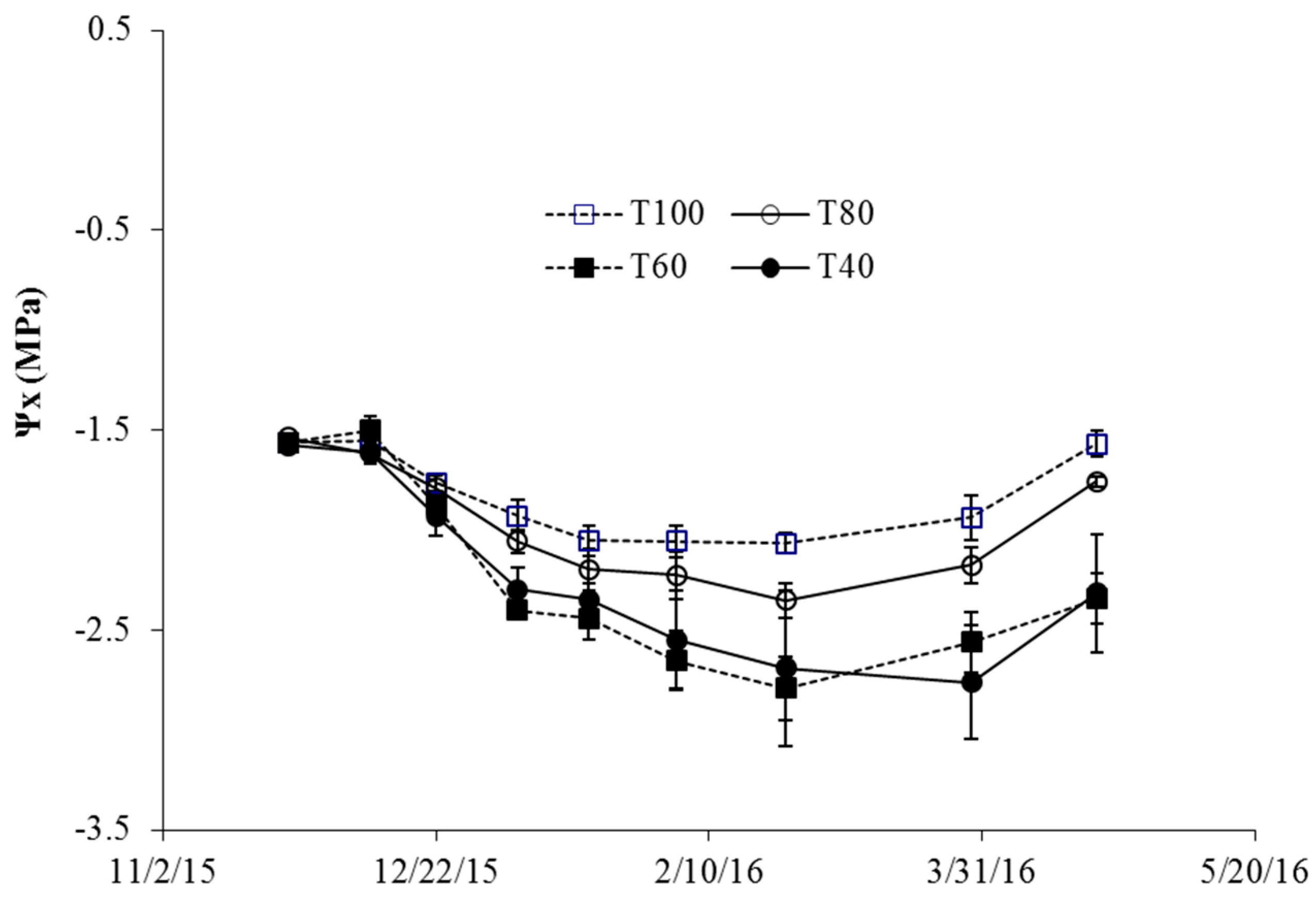
| Block | Olive Variety | Spacing | Number of Plants | Blok/Unit | Irrigation Valve | Irrigation Shift | Drip Flow | Drippers Separation | Total Drippers | Precipitation Rate | Total Flow |
|---|---|---|---|---|---|---|---|---|---|---|---|
| [L/h] | [m] | [mm/h] | [m3/h] | ||||||||
| 1 | Arbequina | 6 m × 3 m | 4568 | 1/1 | 1 | 1 | 3.5 | 1 | 13,350 | 1.17 | 47.9 |
| 1/2 | 2 | 4 | 3.5 | 1 | 13,528 | 1.17 | 47.5 | ||||
| 2 | Arbequina | 6 m × 3 m | 4611 | 2/1 | 3 | 2 | 3.5 | 1 | 14,032 | 1.17 | 50 |
| 2/2 | 4 | 1 | 3.5 | 1 | 13,380 | 1.17 | 46.8 | ||||
| 3 | Arbequina | 6 m × 3 m | 4802 | 3/1 | 5 | 5 | 3.5 | 1 | 14,048 | 1.17 | 50.3 |
| 3/2 | 6 | 1 | 3.5 | 1 | 14,110 | 1.17 | 50.2 | ||||
| 4 | Arbequina | 6 m × 3 m | 4851 | 4/1 | 7 | 3 | 3.5 | 1 | 14,152 | 1.17 | 50.7 |
| 4/2 | 8 | 1 | 3.5 | 1 | 14,198 | 1.17 | 50.5 | ||||
| 5 | Coratina | 7 m × 3.5 m | 3696 | 5/1 | 9 | 5 | 3.5 | 0.75 | 15,216 | 1.2 | 54.6 |
| 5/2 | 10 | 4 | 3.5 | 0.75 | 14,942 | 1.2 | 52 | ||||
| 6 | Royal Changlot | 7 m × 3.5 m | 3563 | 6/1 | 11 | 3 | 3.5 | 0.75 | 15,370 | 1.2 | 55.1 |
| 6/2 | 12 | 2 | 3.5 | 0.75 | 15,068 | 1.2 | 52.4 | ||||
| 7 | Barnea | 7 m × 3.5 m | 3667 | 7/1 | 13 | 5 | 3.5 | 0.75 | 15,302 | 1.2 | 54.7 |
| 7/2 | 14 | 4 | 3.5 | 0.75 | 14,038 | 1.2 | 49.8 | ||||
| 8 | Picual | 7 m × 3.5 m | 3231 | 8/1 | 15 | 3 | 3.5 | 0.75 | 14,786 | 1.2 | 53.1 |
| 8/2 | 16 | 2 | 3.5 | 0.75 | 14,922 | 1.2 | 52.9 | ||||
| 9 | Barnea | 7 m × 3.5 m | 1458 | 9/1 | 17 | 4 | 3.5 | 0.75 | 13,842 | 1.2 | 48.6 |
| Koroneiki | 7 m × 3.5 m | 1429 | 9/2 | 18 | 5 | 3.5 | 0.75 | 13,460 | 1.2 | 48.1 | |
| 10 | Frantoio | 7 m × 3.5 m | 3625 | 10/1 | 19 | 3 | 3.5 | 0.75 | 16,250 | 1.2 | 56.8 |
| 10/2 | 20 | 2 | 3.5 | 0.75 | 15,932 | 1.2 | 55.9 |
© 2018 by the authors. Licensee MDPI, Basel, Switzerland. This article is an open access article distributed under the terms and conditions of the Creative Commons Attribution (CC BY) license (http://creativecommons.org/licenses/by/4.0/).
Share and Cite
Capraro, F.; Tosetti, S.; Rossomando, F.; Mut, V.; Vita Serman, F. Web-Based System for the Remote Monitoring and Management of Precision Irrigation: A Case Study in an Arid Region of Argentina. Sensors 2018, 18, 3847. https://doi.org/10.3390/s18113847
Capraro F, Tosetti S, Rossomando F, Mut V, Vita Serman F. Web-Based System for the Remote Monitoring and Management of Precision Irrigation: A Case Study in an Arid Region of Argentina. Sensors. 2018; 18(11):3847. https://doi.org/10.3390/s18113847
Chicago/Turabian StyleCapraro, Flavio, Santiago Tosetti, Francisco Rossomando, Vicente Mut, and Facundo Vita Serman. 2018. "Web-Based System for the Remote Monitoring and Management of Precision Irrigation: A Case Study in an Arid Region of Argentina" Sensors 18, no. 11: 3847. https://doi.org/10.3390/s18113847
APA StyleCapraro, F., Tosetti, S., Rossomando, F., Mut, V., & Vita Serman, F. (2018). Web-Based System for the Remote Monitoring and Management of Precision Irrigation: A Case Study in an Arid Region of Argentina. Sensors, 18(11), 3847. https://doi.org/10.3390/s18113847







